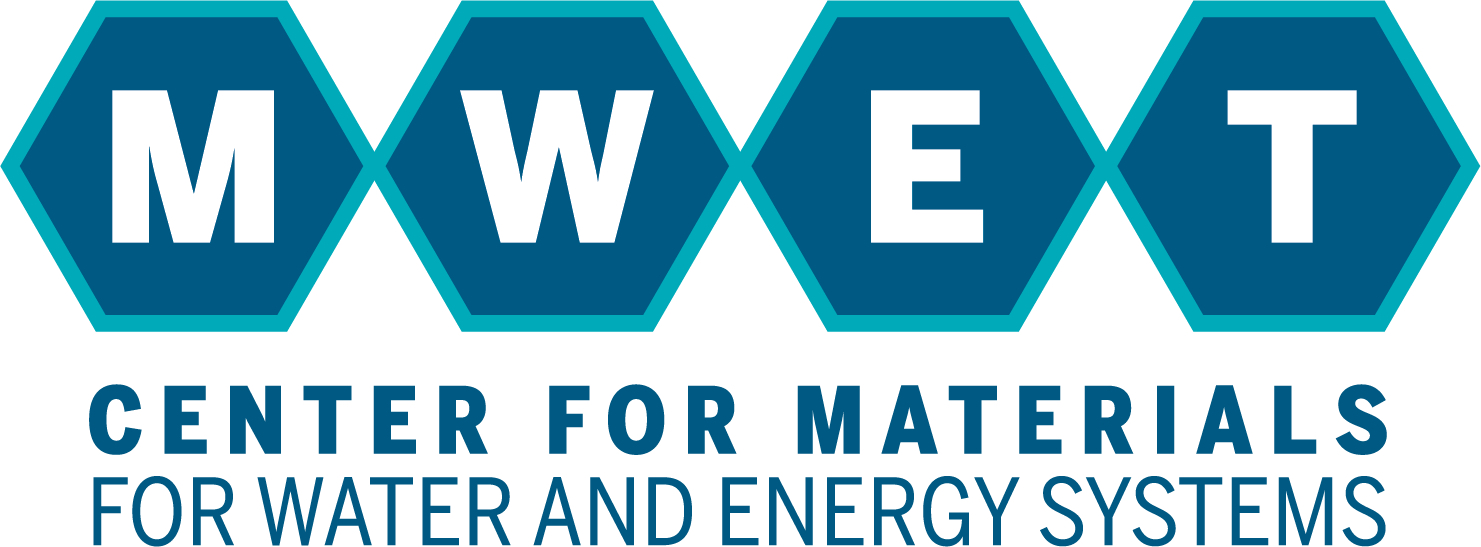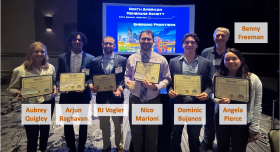Contaminated water from energy-related activities is an enormous burden (wastewater management) and an exciting untapped opportunity (resource recovery). For example, produced water from U.S. oil and gas operations is one of the largest man-made wastewater streams (60 million barrels (9.5 billion liters) per day). More than 90% of this water is reinjected into the subsurface, in part because it is often highly impaired, containing elevated concentrations of organic and inorganic components. Selective decontamination of such water would yield vast new water resources for municipal, industrial, and energy applications, such as power plant cooling water. Moreover, this water can contain high concentrations of resources, such as lithium (e.g., ~1,000 mg/L), which, if recovered, would markedly increase lithium availability for batteries. Similarly, the use of alternative water sources from other sectors could reduce the traditional water source demand within the energy sector.
Synthetic membranes are widely used for purifying relatively clean water (e.g., seawater and brackish water desalination, filtering lake and river water, etc.) via reverse osmosis (RO), nanofiltration (NF), electrodialysis (ED), ultrafiltration (UF) and microfiltration (MF) due to low energy requirements of membranes relative to alternatives (e.g., thermally-based separations). However, today’s membranes were not designed to treat highly impaired waters, such as produced water and mining wastewaters. Membrane treatment for fit-for-purpose reuse of other alternative waters or waste streams including seawater, brackish groundwater, agricultural, industrial and municipal wastewater is also hindered by fouling and poor separation of contaminants of concern.
Existing membranes: (1) are poor at discriminating between ions of the same valence (e.g., Na+ v. Li+), (2) have low selectivity for many neutral contaminants (e.g., boron, arsenic), (3) are always subject to fouling, (4) exhibit a pernicious tradeoff between permeability and selectivity, and (5) are produced in poorly understood, highly non-equilibrium processes that limit deliberate control of their properties.
Lack of basic science understanding prevents: (1) rational tailoring of fouling-resistant membrane surfaces, (2) synthesis of dense membranes with desired functionality to selectively and rapidly permeate or react with specific solutes, and (3) precise tuning of pore size and pore size distribution in UF and MF membranes to prepare highly permeable, selective porous membranes.
Membranes interact with complex aqueous mixtures at interfaces and over vast ranges of length scales. Fundamental knowledge gaps exacerbating membrane design challenges include: (1) structure/dynamics of hydration water and solutes (e.g., ions, dissolved organics, etc.) near membrane/fluid interfaces, in membrane separation layers, and in pores, (2) thermodynamic and kinetic properties (e.g., activity and diffusion coefficients) of solutes in aqueous mixtures, near membrane/fluid interfaces and in membranes that depend, in part, on solute (e.g., different ions have drastically different solvation free energies) and surface hydration properties, and (3) rational design of selectivity-enhancing interactions between water, solutes and membranes.
Due to the complexity of the problem, only subsets of these challenges have been addressed, often in isolation by a single PI or small group (e.g., studying fouling-resistant surfaces or characterizing structure/property relations in membrane separation layers). These fragmented, disconnected efforts have not produced disruptive membrane improvements (e.g., current desalination membranes are based on chemistry developed in the 1970s). Addressing these basic science gaps to achieve truly groundbreaking progress requires an EFRC-scale activity harnessing the brightest materials scientists, theoreticians, advanced characterization specialists, and experts in membrane applications, water chemistry and processes working together. To this end, the mission of the Center for Materials for Water and Energy Systems (M-WET) is to discover and understand fundamental science to design new membrane materials, develop tools and knowledge to predict new materials’ interactions with targeted solutes, inspired by the need to provide fit for purpose water from low quality water sources and recover valuable solutes with less energy.
We propose 3 Gap Attack Platforms (GAPs) to achieve this goal: (A) Structure and Dynamics of Water and Solutes Near Interfaces, (B) Molecular Design for Ion Selectivity, and (C) Fundamental Science of Membrane Manufacturing. These GAPs will work with an overarching Integrating Framework on (4) Bridging Between Systems/Developing the Bridging Toolset.
M-WET’s team comprises 22 leading membrane scientists, polymer scientists, polymer physicists, materials scientists, theoreticians, chemists and beamline scientists at UT Austin, UC Santa Barbara, and the Advanced Light Source (ALS) at LBNL. The key to M-WET’s previous and future success is an organization directing the flow of scientific advances between GAPs to catalyze systems level breakthroughs.
M-WET’s previous success was enabled by the center-wide adoption of a Universal Membrane Chemistry Platform (UMCP) and a Model Fluid Platform (MFP), which kept research projects synchronized across M-WET and well-aligned with our mission and research goals.
In this renewal period (August 2022 to July 2026), the UMCP will be further tailored and updated to include a scalable library of materials continuously evolving to supply MWET’s GAPs and IF. UMCP derived materials, designed to target MFP solutes, such as boron and lithium, have yielded best in class ion separations (e.g., the highest Li+/Na+ selectivity ever reported for a polymer). This achievement was only possible via contributions from team members with expertise in polymer science, membrane science, aquatic chemistry, simulation, synchrotron studies, and NMR. Ambient pressure x-ray photoelectron spectroscopy (APXPS) studies provided the first direct measurements of the Donnan potential. Energy-resolved resonant x-ray scattering coupled with macroscopic membrane measurements provided nm resolution of the structure and composition of calcium-bridged natural organic matter fouling layers and their connection to membrane fouling. Now, in-operando measurements of these phenomena will reveal the key role of water in solute selectivity, transport, and fouling and permit unprecedented basic science studies of membrane formation mechanisms and dynamics. An elusive goal for the membrane industry is scalable manufacturing of isoporous membranes to break the selectivity/permeability tradeoff. While our work on equilibrium selfassembly of UMCP materials to make isoporous membranes yielded fundamental insights regarding the role of pore structure on transport, practical-scale adoption requires phase inversion techniques. Fundamental insight into such complex, far from equilibrium processes will enable rapid implementation across new membrane chemistries (e.g., beyond polysulfone and related conventional membrane polymers). Combinatorial and high throughput methods will also be harnessed to rapidly characterize solute-solvent-membrane interactions to markedly accelerate evolution of new membrane technologies.
M-WET’s team is adapting to ensure that the team’s expertise is well-aligned with the proposed research. M-WET’s original team had 21 PI’s, and the renewal team has 22 PI’s. Ten of the renewal PI’s were not part of M-WET’s original team: Christopher, Clément, Dortdivanlioglu, Henkelman, Kumar, McReynolds, Page, Sanoja, and Su. These new team members bring specific expertise in mechanical properties of soft materials, theoretical chemistry, interactant synthesis, electrochemistry, selective membrane design, database development, and in-operando NMR and synchrotron beamline techniques that bear directly on M-WET’s future research directions.
To overcome current membrane deficiencies and address the overarching question (i.e., how do fundamental atomic, molecular, and mesoscale interactions between water, solutes, and polymers lead to scalable membrane designs to address a wide array of potential contaminants?), M-WET previously deployed 3 GAPs and an Integrating Framework (IF). Based on our success, we are re-envisioning the GAPs and IF. GAP A is a natural extension of our previous GAP 1 and focuses on interactions of water and solutes with surfaces/interfaces. GAP B explores molecular designs for targeting high selectivity and addresses the impact of hydration on solute properties and membrane performance, and GAP C develops the fundamental science of membrane manufacturing; these two GAPs are new. Each GAP combines novel materials synthesis, development of new characterization techniques aimed at understanding the interaction of aqueous fluids with polymeric membrane materials, and development of new theory and simulation tools. The cross-cutting IF continues to bridge between GAPs and develops toolsets to translate all advances to system-level benefits. The IF will maintain our modular model materials platform, the UMCP, and evolve it to incorporate new discoveries, so breakthroughs transfer seamlessly among GAPs and across length scales. A sufficiently sized materials repository will be synthesized to fulfill the needs of all 3 GAPs. The initial UMCP already includes structural elements, pore wall functional units, and, if needed, sacrificial elements that are removed to provide pores. The IF also maintains the MFP to provide continuity, coherence, and relevance among research projects. Toolset development includes advances in operando measurements, leveraging our approved program at LBNL’s Advanced Light Source, the Molecular Foundry (molecular simulation of spectroscopic data), and our general user proposal at National Synchrotron Light Source-II, as well as high throughput measurement platforms to accelerate materials discovery and analysis.
The Universal Membrane Chemistry Platforms, UMCPs, catalyze integration of the three GAPs by providing two unified materials platforms to which new functional moieties can be modularly displayed: a porous UMCP and a non-porous UMCP. The non-porous UMCP is built on a versatile platform previously developed in M-WET based on copolymers of poly(ethylene glycol) acrylates and pentafluorophenyl acrylate (PFPA) that can be functionalized post-polymerization by a wide variety of substituents. This platform provides a high degree of control over cross-linking density, water uptake, and functional group incorporation that will allow us to develop structure−property relationships for a range of basic, acidic, and solute-chelating moieties which enables efficient screening of chemical functionalities across the microscopic and macroscopic studies proposed in GAP A-B and seamless incorporation into the porous UMCP by the other GAPs and IF. The molecular architecture of this non-porous platform can also be controlled to form block copolymer micelles (via living free radical polymerizations for studying the role of functional groups on water dynamics), cross-linked hydrogels (via incorporation of diacrylates), and microparticles with controlled surfaces/interiors (via flow chemistry).
Google Scholar
Center for Materials for Water and Energy Systems (M-WET) Google Scholar











